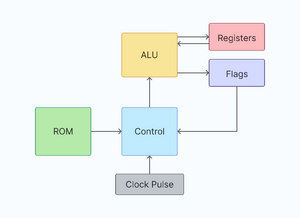Your First Computer: Difference between revisions
Appearance
add stub indicator |
m Make external link external |
||
| Line 1: | Line 1: | ||
{{stub}} | {{stub}} | ||
If you're a new player, you might have already built a few circuits already: an [[Full Adder|adder]], some kind of memory, a [[decoder]]. But getting to the next level where you have a functioning and [ | If you're a new player, you might have already built a few circuits already: an [[Full Adder|adder]], some kind of memory, a [[decoder]]. But getting to the next level where you have a functioning and [https://en.wikipedia.org/wiki/Turing%20completeness turing complete] computer, is incredibly daunting. This article will serve as a guide to how you might build your first computer. | ||
[[File:Computer Structure diagram.png|300px|right|thumb|The structure of the computer in this article]]Every computer follows this simple process: | [[File:Computer Structure diagram.png|300px|right|thumb|The structure of the computer in this article]]Every computer follows this simple process: | ||
Revision as of 15:58, 7 September 2025
If you're a new player, you might have already built a few circuits already: an adder, some kind of memory, a decoder. But getting to the next level where you have a functioning and turing complete computer, is incredibly daunting. This article will serve as a guide to how you might build your first computer.

Every computer follows this simple process:
- A place that stores instructions sends an instruction to the computer.
- The instruction gets decoded by the control, and tells the rest of the computer what to do.
- Sometimes these instructions the Arithmetic and Logic Unit (henceforth, ALU), to operate on data given by the registers.

